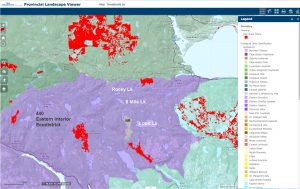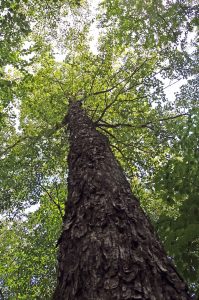
Ecodistricts and the Old Forest Policy layers in the vicinity of Loon Lake. Source: Nova Scotia Landscape Map Viewer, accessed 23 Mar 2018.
Click on image for larger version
Let’s get this straight. Official provincial policy is to “conserve the remaining old-growth forests on public land” (2012 policy document). Great. Except, that is, if there is more than eight per cent of it in a particular eco-district. Once that eight per cent has been protected, according to Department of Natural Resources regional manager Mark Pulsifer, the department can allow cutting “in areas that could qualify as old-growth forest.” So the most ecologically valuable old-growth forests — ones in larger, contiguous chunks — are not, in fact, protected.
Read more in READER’S CORNER: Biomass burner an abomination
By Nina Newington, Chronicle Herald, Mar 23, 2018
The 8% claim is worse than NN may realize, as most of what’s included in the 8% is in “restoration opportunities”, not in actual Old Growth which collectively is well under 0.5% of our forested area. Also, look at the Old Forest Policy layer in the Loon Lake area (Map above) – there are no patches in the Loon Lake/Eight Mile Lake/Rocky Lake area, not even the Loon Lake Nature Reserve is recognized as supporting Old Growth.
 Then there is the technical snag that NSDNR requires that “Selections [of candidates for Old Growth status] must be large enough to be identified as a stand in the GIS”. As a lot and perhaps most of the Old Growth that is left outside of designated protected areas exists in patches that were simply missed when harvesting was carried out years ago (as Bob Bancroft discussed on the Rick Howe Show), these patches will rarely correspond in area to designated GIS stands (polygons), and hence will not qualify as Old Growth under NSDNR’s scheme.
Then there is the technical snag that NSDNR requires that “Selections [of candidates for Old Growth status] must be large enough to be identified as a stand in the GIS”. As a lot and perhaps most of the Old Growth that is left outside of designated protected areas exists in patches that were simply missed when harvesting was carried out years ago (as Bob Bancroft discussed on the Rick Howe Show), these patches will rarely correspond in area to designated GIS stands (polygons), and hence will not qualify as Old Growth under NSDNR’s scheme.
NSDNR has shown it is unwilling to proactively search out and protect patches of genuine old growth outside of its now mostly designated 8% target area. As pointed out in a recent review of Old forest policy and regulatory frameworks in Nova Scotia New Brunswick with a comparison to British Columbia*, NSDNR it is particularly averse to protecting Old Growth stands that have commercial value, except when they are inaccessible.
There’s lots more to be upset about, as NN recounts, concluding:
Instead of rigorous provincial oversight of our public lands, the mill has its way, destroying the little that’s left of our most valuable forests to burn for biomass. The only way we even know about this is because a forester with guts and a camera contacted The Chronicle Herald.
Whom do we trust? Not DNR. It’s time to shut down that travesty of green energy, the biomass burner, and bring in managers at DNR who will do what Nova Scotians have repeatedly asked them to do: protect our forests.
Amen to that.
Thanks Nina Newington and thanks again, Danny George and Aaron Beswick/the Chronicle Herald.
View previous posts about Loon Lake area harvests
———————
*Old forest policy and regulatory frameworks in Nova Scotia and New Brunswick with a comparison to British Columbia
Amy Berry, Amanda Lavers and Lisa Mitchell The Forestry Chronicle, 2018, 94(1): 13-19
The authors conclude that “Nova Scotia [has a] strong old forest policy underpinned by a quantitative scoresheet, coordinator, and database”, but that it lacks a regulatory framework and has not provided evidence of having reached its conservation targets. They note that “British Columbia has integrated Forest Stewardship Plans that promote the retention of OGF [Old Growth Forest] as legally enforceable tools for licensees in Old Growth Forest Management Areas” and suggest that “such an approach could prove useful in improving the restoration and conservation of OGF in the Maritime Provinces”. (They note that “less than 1% of the total forest cover in [NB and NS] is OGF” and that “this is drastically lower than the 55% represented in British Columbia’s Temperate Coastal Rainforest”.)
I agree that the quantitative scoresheet that NDSDNR has devised makes it operational in practical terms (I have used the scoresheet), and I understand from the paper that an equivalent tool is not available in most other jurisdictions. However I see the requirement I noted above (“Selections [of candidates for Old Growth status] must be large enough to be identified as a stand in the GIS”), as a serious limitation to its utility for protecting Old Growth stands. There are a number of improvements that could be made to give more weight to ecological characteristics of Old Growth; currently, the scores are influenced primarily by forestry metrics.
